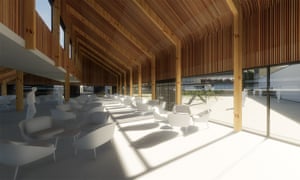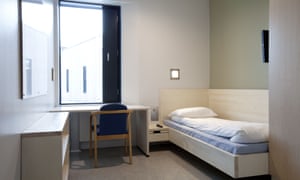[ad_1]
A huge image of a snowcapped mountain covers the wall at the end of a long corridor of cells in Her Majesty’s Prison Berwyn, providing a glimmer of relief from the sterile landscape of indestructible concrete walls and wipe-clean floors, flooded with harsh white light.
What the polished PR images of the model £220m “super-prison” in Wrexham, north Wales, don’t convey is the constant echo of banging doors and shouting; the lack of ventilation, or the fact that the cell ceilings are so low you can press your hand flat against them. Nor do they show that Berwyn has some of the country’s highest rates of violence, weapon finds and “use of force” incidents by staff. Nor that the workshops still remain unfinished two years after the prison opened.
Originally planned to be one of the cheapest Category C jails to run in England and Wales, housing 2,100 men at £14,000 per year per place, HMP Berwyn is currently one of the most expensive, standing 40% empty and costing £36,000 per prisoner each year. It has been dubbed a “catastrophic failure”, yet it embodies the latest in prison thinking in the UK – which holds the title of the most incarcerated nation in western Europe. Recent analysis found the rate of imprisonment in England and Wales is about twice as high as Germany and roughly three times that of Italy and Spain. And it’s only set to rise.

Boris Johnson’s recent announcement of 10,000 extra prison places comes at a time when our penal system is on its knees, with services slashed to the bone after years of cuts. Jails are beset by chronic overcrowding, drug use, mental illness and self-harm. Deaths have risen by 20% in less than a year. Recent inspections report filthy cells, stinking unscreened toilets, broken windows, exposed wiring and heaps of rubbish infested with vermin. In a damning indictment of the levels of squalor, a Dutch court recently refused to extradite a prisoner to England on the grounds that the conditions awaiting him would be “inhumane and degrading”.
It is against this bleak backdrop that the Ministry of Justice has allowed architects Bryden Wood to promote their plans for HMP Wellingborough, a £253m 1,600-capacity prison currently under construction in Northamptonshire. Claiming to be the product of “the largest research project of its kind”, the designs have done away with Victorian-style gallery cell blocks, removed the bars from windows, and arranged the cells in smaller groups around landscaped courtyards. The visitor centre promises to be an airy timber-lined hall more akin to an Ikea cafe.
“We really started from first principles,” says Jaimie Johnston, director of Bryden Wood. The practice was commissioned in 2016 to come up with a standardised design that could be rolled out in a £1.2bn programme of super-prisons – a pre-existing plan that the new prime minister has merely re-announced. “The idea was to put loads of time and effort into understanding the optimum design of a house block,” he adds. “If you’re building 10,000 cells, it’s worth spending ages getting the cell absolutely right.” It was supposed to be the ultimate flat-pack kit for incarceration by numbers, fine-tuned for efficiency and cost-effectiveness.
Using virtual reality modelling, the architects tested countless layouts with prison staff, tweaking corridor widths and lengths, adjusting ceiling heights and modelling acoustics to come up with a layout that struck a balance between prisoner rehabilitation and operational efficiency – the two chief parameters of prison design, usually diametrically opposed, with the latter generally coming out on top.

The most radical changes in the resulting Wellingborough plan include getting rid of the familiar two-storey atrium arrangement with galleried landings – loved by prison officers for the visibility they allow between floors, but which result in hellish echo chambers – and ditching the usual K-shaped formation of the housing blocks.
The K-block, instantly recognisable as a prison from the air, has lingered for generations as a hangover from the panopticon ideal, developed by 18th-century reformer Jeremy Bentham. In theory, a single prison officer placed in the centre of the radial arms of corridors could “survey of the whole establishment in the twinkling of an eye”, while imparting in the prisoners a crushing sense of constant surveillance. Pentonville prison, which opened in London in 1842, set the standard with radial wings, galleried landings and all-pervasive grimness. Even contemporary commentators described it as “unnecessarily cruel” and posited that “madness will seize those whom death has spared”. Yet, over the following six years, 54 prisons were built to exactly the same template, from Preston to Leeds and Manchester, and the same basic principles have remained unchanged in modern super-prisons.
Bryden Wood’s housing blocks attempt to be a little more humane. Their staggered cross-shaped form breaks up the corridors into smaller, more social zones, where prison staff might be able to develop better relationships with prisoners through more direct contact and conversation, rather than the usual physical separation and anonymity of miles of corridors. The perpendicular wings create usable outdoor space for sports and gardening, rather than awkward triangles left over in the armpits of a K-block, while a central hub will provide education, vocational training and social facilities in one place, “like a high street”, says Johnston – rather than scattering the facilities across the sprawling campus.
These details aside, however, it looks very much like business as usual: endless warehouse-like sheds punctuated by tiny square windows, forming an institutional assembly line for inmates to be processed like Amazon parcels. The design of the cells remains confidential, while a source close to the project says there has been significant “value engineering”, including the removal of the acoustic treatment. (An MoJ spokeswoman said: “We have worked closely with [contractor] Kier over the design at HMP Wellingborough, making improvements to each area of the prison at a price that is affordable for the taxpayer.”) While the whole scheme was specifically designed for off-site prefabrication and repeatable economies of scale, it is instead being built with conventional construction methods, and will likely remain a one-off.

Architect Roland Karthaus, whose in-depth research on prison design won a RIBA award last year, points to procurement as the biggest obstacle in realising decent, humane prisons. “In the past, a brief has been developed, then sent out to contractors, who appear to value engineer it to death,” he says. “There doesn’t seem to be any process of actually valuing what the impact of those changes might be.” He says the low cell ceilings in HMP Berwyn were a result of cost-cutting, without due concern for the psychological impact of squeezing the prisoners’ personal space. Karthaus also found that the layout of furniture in Berwyn’s cells meant it was impossible to do press-ups on the floor, while the way the ventilation grilles had been fitted essentially made them redundant.
The failure of the modern prison estate is all the more galling given the extensive wealth of knowledge that exists in academia and practice about how to design environments that are actually conductive to rehabilitation. Johnston says his team constantly showed their client world-leading examples, such as Norway’s celebrated Halden prison – where inmates are trusted with kitchens equipped with knives to cook their dinner, and there’s a little house on the campus where prisoners can stay with their families for a night – but that such features would require a fundamental shift in how we think about incarceration in this country.
“The Scandinavian mindset is that if someone is in prison, that’s our fault as a society,” he says. “We let you fall through the cracks, so it’s our responsibility to rehabilitate you.” Bryden Wood’s design process, by contrast, was haunted by the spectre of the Daily Mail test, forever mindful of “Holiday camps for prisoners!” headlines if their plans were deemed too cushy. Prisons in England must not only punish, but be seen to punish, with politicians constantly citing public opinion to justify draconian measures.
So are we stuck with a template that remains basically unchanged since the publication of Hints for the Improvements of Prisons in 1817, which prescribed that the buildings should be “made as gloomy and melancholy as possible”?

According to Yvonne Jewkes, one of the UK’s leading prison academics, we shouldn’t be surprised that history continues to repeat itself, given the “pervasive cautiousness perpetuated by an intricate network of individuals, companies and capital, and driven primarily by concerns for security, cost and efficiency.” She points to the privatisation of both the construction and management of prisons in the 1990s as enshrining short-term cost-saving over long-term benefit. But she sees signs of hope in Scotland’s prison programme, where three new prisons built since 2012 – HMP Low Moss, HMP Shotts and HMP Grampian – show a “nod to Scandinavia” in their more open, community-facing designs. Karthaus says the key to Scotland’s success is the smaller scale of the operation: all the decision-makers can sit in a room and agree on the design, something that is currently impossible in England’s bloated super-prison system.
Just as building more roads brings more traffic, history has shown that if you build more prisons, the prison population will only increase. A recent report by the Prison Reform Trust described an “addiction to imprisonment”, and found that the number of people behind bars in England and Wales is nearly 70% higher than three decades ago. If Boris Johnson has any intention of reducing reoffending – which currently costs the taxpayer around £15bn a year – he should focus on reducing the number of prison places, and prioritise rehabilitation over packing as many people as possible into ever more damaging containers.
[ad_2]
READ SOURCE


